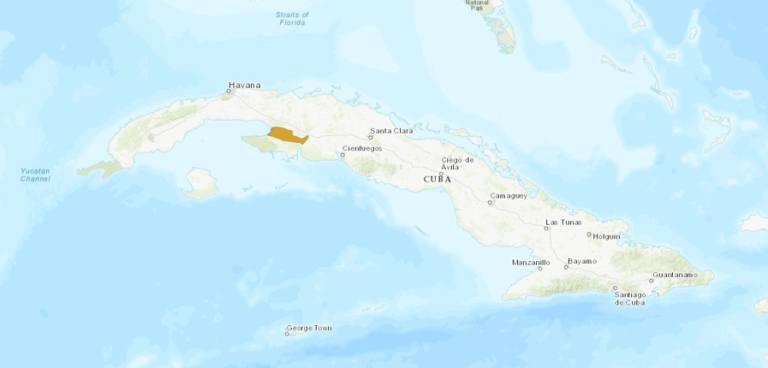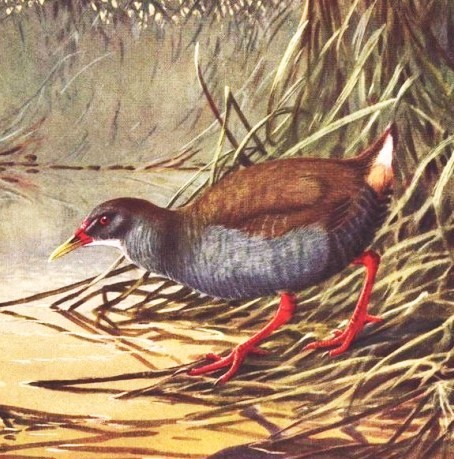Birdfinding.info ⇒ An extremely rare, critically endangered, and little-known Cuban endemic that has been observed very few times, mostly in the 1920s and ‘30s. The locations where it has been reported are Santo Tomás, Laguna del Tesoro, Peralta, Hato de Jicarita, and most recently La Turba in 2014.
Zapata Rail
Mustelirallus cerverai
Endemic to the Zapata Swamp region of western Cuba, where it inhabits dense, bushy swamps with low trees and a mix of sedges, sawgrass, and cattails.

Approximate range of the Zapata Rail. © BirdLife International 2016
There is a limited history of documented observations. From 1927 to 1934, it was readily found at Santo Tomás and several specimens were collected. The next observations were in the 1970s at Laguna del Tesoro, documented with at least one photograph. Then in 1998, surveys detected it again at two new locations: Peralta and Hato de Jicarita. Most recently, in November 2014, dedicated surveys at La Turba led to a sighting and photograph.
Identification
A medium-large, flightless or nearly flightless rail with dull-brown upperparts, lead-gray underparts, a whitish throat, a medium-length, orange-and-red bill, and short, coral-red legs.

Zapata Rail. © Guy Kirwan
Notes
Monotypic species.
IUCN Red List Status: Critically Endangered.
References
BirdLife International. 2016. Cyanolimnas cerverai (errata version published in 2018). The IUCN Red List of Threatened Species 2016: e.T22692737A125415972. http://dx.doi.org/10.2305/IUCN.UK.2016-3.RLTS.T22692737A93367710.en. (Accessed August 23, 2020.)
Edge of Existence. 2020. 72. Zapata Rail. http://www.edgeofexistence.org/species/zapata-rail/. (Accessed August 23, 2020.)
Garrido, O.H, and A. Kirkconnell. 2000. Field Guide to the Birds of Cuba. Cornell University Press.
Kirkconnell, A., O. González, E. Alfaro, and L. Cotayo. 2016. Nuevas localidades para la Gallinuela de Santo Tomás Cyanolimnas cerverai y la Ferminia Ferminia cerverai, en la Ciénaga de Zapata, Cuba. http://www.neotropicalbirdclub.org/wp-content/uploads/2016/02/Cotinga-12-1999-57-60.pdf.
Kirwan, G.M., A. Levesque, M. Oberle, and C.J. Sharpe. 2019. Birds of the West Indies. Lynx Edicions, Barcelona.
Navarro, N. 2015. Field Guide to the Endemic Birds of Cuba. Ediciones Nuevos Mundos, St. Augustine, Florida.
Raffaele, H., J. Wiley, O. Garrido, A. Keith, and J. Raffaele. 1998. A Guide to the Birds of the West Indies. Princeton University Press, Princeton, N.J.
Ripley, S.D. 1977. Rails of the World: A Monograph of the Family Rallidae. David R. Godine, Publisher, Boston.
Taylor, B., and B. van Perlo. 1998. Rails: A Guide to the Rails, Crakes, Gallinules, and Coots of the World. Yale University Press.
Taylor, B., G.M. Kirwan, and C.J. Sharpe. 2019. Zapata Rail (Cyanolimnas cerverai). In: del Hoyo, J., Elliott, A., Sargatal, J., Christie, D.A. & de Juana, E. (eds.). Handbook of the Birds of the World Alive. Lynx Edicions, Barcelona. https://www.hbw.com/node/53671. (Accessed June 24, 2019.)
Walker, M. 2015. Incredibly Rare Bird Sighted: The Critically Endangered Zapata Rail is finally seen after more than 40 years. March 2, 2015. http://www.bbc.com/earth/story/20150302-incredibly-rare-bird-sighted.
